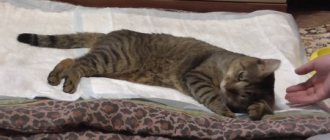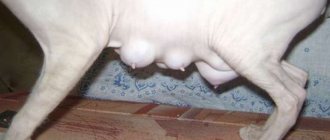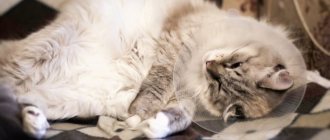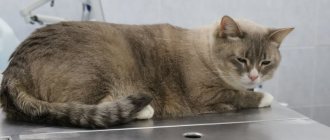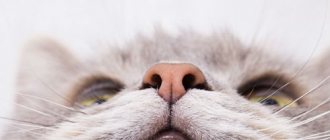Causes of black feces in cats
When the feces are black in color and the pet is feeling well, the anomaly is explained by natural causes.
The presence of additional symptoms is a cause for concern.
Physiological reasons
Blackening of cat feces is always a mistake by the owner, which can lead to dire consequences. However, one-time darkening is not a cause for concern.
The anomaly is explained by the following reasons:
- A large amount of iron enters the intestines , which interacts with food masses and forms harmless black compounds. If the animal owner notices that an abnormality has occurred after using a food supplement, it should be discontinued.
- The cat was treated to meat scraps or raw liver, which contain a lot of iron. If the diet contains a lot of raw meat, the feces will always be black, and the cat runs the risk of becoming infected with helminths.
- The animal was given a drug or food containing colored pigments , such as activated carbon. Gourmet cats have strange preferences: either give them raw potatoes, or cucumbers, or cherries. In the latter case, the feces become black.
Be sure to read: A cat has dark urine: causes and treatment, what should be normal, what the change in color indicates.
Although a single blackening does not cause immediate harm to health, the owner of the animal should not allow the situations described to repeat. And it’s not so much a matter of excess iron as it is a matter of protein overfeeding, a deficiency of dietary fiber and the danger of becoming infected with parasites or microbes that contaminate the meat.
Pathological causes
If the stool becomes black for a long time, this is an alarming symptom. There is only one reason: the entry of large amounts of iron into the intestines. Blood contains the most metal compounds.
Therefore, black staining of stool always indicates bleeding in the anterior intestine under the influence of the following factors:
- High worminess. Parasitic worms injure the mucous membrane of the small intestine and feed on blood. Part of the biological fluid is digested by the body's enzymes.
- Traumatic gastritis or colitis, accompanied by bleeding.
- Gastroenteritis , which occurs under the influence of pathogens of infectious diseases or toxic substances.
- A tumor process in the digestive organs, accompanied by destruction of the walls of blood vessels.
- The formation of gastric or intestinal ulcers under the influence of food or abuse of oral non-steroidal anti-inflammatory drugs.
A pathological symptom indicates the occurrence of a serious illness and the need to seek veterinary help.
Possible reasons
The color of feces may change to black if there is undigested blood in it, which came from the gastrointestinal tract. If the cat feels well, he is active and cheerful, then black feces are observed due to:
- consumption of raw meat;
- the use of iron supplements, as well as supplements and vitamins.
Sometimes the reasons may be different. They are more serious and require close attention from the breeder. If there is even the slightest doubt, then you simply need to rush your cat to the doctor. This could be the following disease:
- Helminths. These parasites, as a rule, settle in the small intestine and fixate on the mucous membrane, damaging the intestinal walls. The blood from the wound is digested and turns the feces dark.
- Gastritis or colitis that develops as a result of injury. If a foreign body enters the gastrointestinal tract, its walls are damaged, microcracks, wounds or even perforations occur. The blood that is released during this process makes the cat's feces look charcoal.
- Gastroenterocolitis of a hemorrhagic nature is an inflammatory disease in which small vessels can exfoliate along with the epithelium and at the same time release blood into the gastrointestinal tract. This may be due to bleeding disorders, stress, autoimmune diseases, or food intolerances.
- Lymphoma or adenocarcinoma, in which ulcers appear on the intestinal walls, as well as the gastric mucosa. Blood is released and, as a result, the stool turns black.
Also, the black color of feces may indicate constipation, poor digestion or poisoning.
What to do for prevention?
Preventive measures involve systematic treatment for worms.
Liquid or dry feces, which are constantly observed in a pet, in any case, are evidence of some kind of internal progressive disorder. To prevent consequences dangerous to the cat’s health and life, it is important to follow preventive rules. First of all, it is important to monitor the cat’s nutrition and provide it with fresh and clean water. Do not forget to carry out preventive anthelmintic treatment. If viral infectious diseases develop, do not self-medicate, but take the animal to a veterinarian, who, based on the diagnostic results, will select an effective treatment. In order for the cat’s body to more actively resist various diseases, it is useful to strengthen the pet’s immunity. To do this, it is recommended to give courses of vitamins and various biologically active supplements, which are selected by the veterinarian, taking into account the individual characteristics of the cat.
What can black feces mean in cats?
Black feces indicate that excess iron has entered the intestines. Most often, the anomaly occurs due to bleeding in the front of the digestive tract. Even short-term blackening, if it occurs frequently, can cause chronic diseases that destroy the health of the pet.
Diets based on raw meat, as a rule, contain excess protein and lack of dietary fiber, and therefore cause chronic diseases of the digestive system.
Brown-black cat feces with an unpleasant odor
In case of ulcerative pathologies or diseases of the pancreas, the animal’s own enzymes are not active enough. A significant portion of the nutrients remains undigested. It enters the large intestine, where it becomes prey for putrefactive microbes. Feces acquire an unpleasant odor, which is characteristic of rotting meat or rancid oil.
Be sure to read: The kitten has bad breath: reasons, what to do, when it is an alarming symptom, prevention
Black feces are detected and the animal does not eat anything
A very bad sign. It is characteristic of panleukopenia, a disease of young animals accompanied by severe dehydration. The animal stops eating in a pre-agonal state. Feces may darken due to either bleeding or pre-mortem changes. The pet needs urgent veterinary care.
What if your cat has black, liquid stool and vomits?
A combination of black diarrhea, vomiting, refusal to feed, and a depressed state are signs of high infestation. Before deworming, it is necessary to stop the bleeding. Parasite control must be carried out under the supervision of a veterinarian.
Even with the correct dosage, intoxication cannot be ruled out, because before death, helminths release an increased amount of toxic decay products.
During autumn deratization, many mice poisoned with anticoagulants appear. They are easy prey. The poison affects cats even more strongly than rodents. Vomiting, black feces, depression and severe dehydration appear. If immediate help is not given, the cat will die.
Treatment rules
If you find black feces in a kitten, you should not treat it on your own, as this can worsen the problem. The most correct decision would be to contact a veterinarian, who will immediately examine the animal and prescribe the correct treatment. Any missed minute can cause the cat's death.
If, in addition to the fact that the cat’s stool is black, it is also of a dense consistency, then the animal simply needs a large amount of drink. In addition, it is imperative to replace dry food with fresh or canned food.
If the stool resembles tar, then the animal should get to the veterinary clinic as quickly as possible. This indicates internal bleeding, and this situation most often ends in death for cats if the animal is not provided with qualified assistance in time.
The causes of black feces in a cat can be very different, but all of them are signals that a veterinarian examination is necessary. Only he can authoritatively say what happened, correctly diagnose the cat and cure it.
In cats, the color of feces is determined by bile, which flows from the gallbladder into the lumen of the duodenum in a certain amount. This happens when the animal is healthy. Normally, cat feces are dark brown in color, and most pathologies of the gastrointestinal tract associated with the flow of bile into the small intestine can be determined by changes in their shade. White feces in a cat is an alarming sign, which should be a reason for increased attention to the health of your mustachioed pet and an incentive to consult a veterinarian.
A coprogram is...
Chyme, or food gruel, moves through the gastrointestinal tract and fecal masses are formed in the large intestine. At all stages, breakdown occurs, and then absorption of useful substances occurs. The composition of the stool helps determine whether there are any abnormalities in the internal organs. A scatological examination helps to identify a variety of diseases.
A coprogram is a chemical, macroscopic, microscopic examination, after which a detailed description of the feces is given. Coprograms can identify certain diseases. These may be disorders of the stomach, pancreas, intestines; inflammatory processes in the digestive tract, dysbiosis, malabsorption, colitis.
Why is this happening?
There can be a lot of reasons. But, frankly speaking, intestinal problems after surgery are a more than common situation. Firstly, general anesthesia can lead to “inappropriate” reactions of the autonomic nervous system, which include increased intestinal motility. If your pet passes away several times during the postoperative period, then there is most likely nothing wrong with it.
The main thing is not to let your cat eat heavily at this time: regular food will not be digested, which can lead to serious consequences. It will simply begin to rot, which can provoke not only “banal” poisoning, but also severe inflammatory bowel diseases.
Let's look at other possible causes of cat diarrhea:
- Bacterial, viral, protozoal infections, mycoses and intestinal parasites . During any operation, there is some probability of pathogenic and conditionally pathogenic microflora entering the surgical area.
- Some medications and toxic substances.
- Inflammatory diseases of the small or large sections (enteritis and colitis, respectively) of the intestine.
- Intolerance to certain types of food or food allergies.
- Oncological diseases.
- Partial intestinal obstruction . Alas, we have already indirectly talked about the reason for this. If you feed your cat heavily shortly after it comes out of anesthesia, a similar scenario is quite likely.
- Other systemic diseases such as diseases of the liver, pancreas, kidneys, hyperthyroidism, etc. Note that the veterinarian should know about this even before the operation.
- Lymphangiectasia and other malabsorption disorders . Simply put, the absorbent surface of the intestine, for some reason, loses the ability to perform its working function, causing some nutrients to completely or partially cease to be absorbed. This leads to the consequences that we have already described above - the components of the feed begin to rot, and severe intoxication occurs. Decay products irritate the intestinal mucosa, causing diarrhea to develop.
Treatment of cats with black stools
The primary goal is to stop the bleeding.
The following drugs are used:
- Tranexam;
- Vikasol;
- Aminocaproic acid;
- Dicynone.
The next step is to eliminate the cause of the disease. If a tumor or foreign object is found in the intestine, surgery is performed.
If urgent deworming is necessary, anthelmintic drugs are prescribed.
When the infectious etiology of the disease is established, antiviral drugs, antibiotics, and immunomodulators are used.
For peptic ulcers, as well as gastroenteritis of non-contagious etiology, gastroprotectors are prescribed.
Control measures
If the cat's condition remains stable and there are no further symptoms other than mild diarrhea, food restriction for approximately 12 to 24 hours is recommended. We draw your attention to the fact that it is harmful for cats to starve for more than a day, since their short digestive system does not tolerate such “bullying”. After a daily diet, you can start giving your cat small amounts of boiled chicken and rice (but it’s better not to overdo it with the latter, as severe constipation is possible). If there is no recurrence of diarrhea, you can gradually introduce “normal” food into the diet.
In more severe cases, long-term dietary changes may be required. So, some cats are recommended to be given special medicinal food , which contains dietary fiber that helps normalize digestion. If you don’t have the opportunity to buy them (and they are not sold everywhere), you can use baby food with almost the same success.
If it turns out that diarrhea in an operated animal is caused by helminths , antihelminthic drugs are prescribed (although this should be done before the operation). Two or even three procedures may be required, since the animal’s body, weakened after surgery, cannot resist re-infection. It is extremely important to maintain a high hygienic condition of the premises in which the animal is kept. Treatment is carried out until the eggs of parasitic worms completely disappear from the animal’s feces. Please note that to be sure of a cure, it is necessary to conduct at least three studies with a one-week break.
Important Notes
It was worse when it came to dehydration . An urgent visit to a veterinarian is recommended, since in such cases intravenous administration of buffer compounds is necessary. Simply drinking in these cases is practically useless: the liquid simply does not have time to be absorbed. Firstly, it will “fly out” of the gastrointestinal tract with feces. Secondly, the inflamed mucosa may be physically unable to absorb water. In addition, the liquid will further irritate the already “life-battered” gastrointestinal tract, which will only worsen the situation.
In cases where diarrhea is caused by pathogenic microflora, antibiotics or other antimicrobial agents may be prescribed. In addition, they are prescribed without fail if there is blood in the cat’s stool. The latter indicates the presence of damage to the intestinal mucosa. This is fraught with the development of septic processes and the death of the animal from blood poisoning. To prevent such an outcome, the pet is prescribed broad-spectrum bactericidal drugs.
Finally, astringents , as well as drugs that slow down intestinal motility.
But! Their use is strictly contraindicated in cases where the cat shows signs of a bacterial infection and/or poisoning. If peristalsis in such a situation is slowed down, the volume of toxins absorbed into the blood from the gastrointestinal tract will sharply increase, which obviously will not add health to the animal.
Treatment can be completed only after the complete disappearance of all symptoms of pathology in the animal. The decision on this is made by a qualified veterinarian based on the results of a full examination and tests (blood, feces, etc.).
Treatment tactics depending on the cause of the symptom
When diagnosing stones or neoplasms in a cat, or detecting a foreign object, there is only one way out - surgical intervention. In other cases, the treatment plan is developed individually for each four-legged patient.
The primary task is to stop bleeding. Hemostatic drugs are administered intramuscularly or intravenously. As a rule, Tranexam, Vikasol, Dicynon, aminocaproic acid are prescribed. Information on standard drug treatment is presented in the table:
| Main disease | Group of drugs | Names of drugs |
| Worm infestation | Antiparasitic | Milbemax, Stronghold, Prasitel, Drontal, Dirofen |
| Sand in the gallbladder | Choleretic | Cholenzyme, Allochol, dehydrocholic acid |
| Inflammation | Antibiotics | Streptomycin, Erythromycin |
| Antiviral | Fosprenil, Anandin, Gamapren, Gamavit, Cycloferon | |
| Stomach lesions | Gastroprotectors | De-Nol, Maalox, Almagel, Ranitidine |
Diagnostic methods
Before prescribing diagnostic tests for a four-legged patient, the veterinarian examines him and analyzes information regarding the animal’s living conditions and nutrition, and previous diseases. Data on exactly when the pathological symptoms appeared and the nature of the clinical picture are also important. Information about the diagnostic procedures prescribed to make an accurate diagnosis is presented in the table:
| Diagnostic manipulations | Purpose of the event | |
| Laboratory research | Clinical blood test | Assessment of the condition of internal organs. |
| Blood chemistry | Liver tests to look for liver or gallbladder problems. | |
| Examination of fecal contents | Detection of remains of inflamed tissue, sand, bone fragments, toxic substances, and parasites in feces. | |
| Analysis of urine | Assessment of the general condition of the body. | |
| Instrumental studies | Ultrasound of the abdominal organs | Detection of cysts, neoplasms, fibrous tissue, obstruction of the bile ducts, sand and stones in the gallbladder. |
| Radiography | Detection of neoplasms, cysts, liver enlargements. | |
| Biopsy of affected tissue, usually the liver | Detection of a tumor. | |
When a visit to the vet should not be postponed
Urgent veterinary care is needed for your pet when the following additional symptoms occur:
- stomach ache;
- plaintive meow;
- temperature above 40 °C;
- diarrhea;
- vomit;
- refusal to eat;
- blood clots in excrement.
Be sure to read:
A cat vomits hair: reasons, what to do, medications and folk remedies, prevention
The most dangerous sign is the appearance of melena - feces with a tarry consistency, indicating large-scale bleeding.
Treatment by a veterinarian
Cat owners should immediately realize that it is not white feces, as such, that are being treated, but the cause that led to this condition is being eliminated. The speed of restoration of the color of feces will depend on the severity of the condition and the general condition of the cat’s body at the time of contacting the veterinary clinic. Sometimes it is possible to restore the color of stool within a few days, sometimes treatment will take longer. There are rare cases when the condition may be irreversible (liver block, oncology).
A correct diagnosis can be made based on:
- clinical examination;
- blood tests (biochemistry and general);
- urine and feces examinations;
- Ultrasound;
- x-ray;
- biopsy (usually taken from the liver, but performed quite rarely).
Any therapy will be meaningless without normalizing the cat’s diet or transferring the cat to a special diet recommended by the veterinarian, according to its state of health.
What treatment is used (schedules and course durations are developed only by veterinarians with individual dosage selection):
- hepatoprotectors that normalize liver functions and metabolic processes (thiotriazolin, Essentiale, Hepatovet, Hepatoject);
- choleretic drugs (ursosan, allohol, cholenzyme);
- relieving spasms and biliary-hepatic colic (buscopan, baralgin, papaverine, mebeverine).
No-shpa is highly not recommended for cats due to the high risk of developing unwanted side effects;
- for bacterial inflammation, antimicrobial therapy with antibiotics is indicated (name and dosage are determined only by a veterinarian);
- surgery to remove tumors, tumor areas or part of the affected liver that cannot be restored (if this is permissible in the current situation);
- palliative therapy for cancer lesions;
- anthelmintics if white worms are found in the stool.
Grinchuk Ekaterina Andreevna veterinarian
(c) Veterinary center for the treatment and rehabilitation of animals “Zoostatus”.
Varshavskoe highway, 125 building 1.
Normally, the color of animal stool varies from , to shade. It is quite difficult to reliably indicate the division between dark brown and black colors, however, the truly black color of feces is not normal in cats and may indicate various pathologies. Black liquid feces are called melena. If your pet's stool color has changed to black, and previously the color was different, or additional symptoms are observed, including lethargy, changes in behavior, it is recommended to consult a veterinarian.
An animal needs immediate examination by a veterinarian if it has:
- The presence of blood clots in the stool, which is a sign of bleeding both in the upper parts of the tract (stomach, small intestine) and lower parts (large intestine).
- Abdominal pain.
- Temperature.
- Vomiting, diarrhea.
- Lethargy, refusal to eat.
Diagnostics and therapy
So we found out why cats have black diarrhea. If you observe, in addition to the melena itself, the following signs, you should immediately run to the vet:
- Diarrhea.
- Vomit.
- Pale gums.
- Presence of bruising or other areas of bleeding (indicates coagulopathy).
- Weight loss.
- Poor appetite.
- Excessive drinking and “exorbitant” volumes of urine.
To find out the root cause of what is happening to the cat, the veterinarian will resort to various diagnostic techniques, including x-rays, ultrasound, blood and urine tests , as well as other methods. How is the treatment done? Since melena is not a disease, but only its symptom, the primary pathology that directly leads to intestinal bleeding is treated.
But in any case, the veterinarian will first solve the problem of blood loss. Of course, ideally, a sick pet needs a transfusion, but in a veterinary clinic this is almost unrealistic. We do not have blood banks, and targeted blood collection is carried out only in the largest veterinary centers. So blood loss is partially replaced with plasma or even saline. The main thing is to prevent collapse and reduce the load on the body’s blood depots.
Postoperative recommendations
In general, they are the same for all operations. Here are the basic rules that veterinarians urge to follow when determining the degree of restoration of the functions of the digestive system:
- Immediately after recovery from anesthesia, your pet may exhibit certain “pathologies” in behavior. She can be lethargic or, on the contrary, aggressive. This is a completely normal reaction of the body, but you must remember that all effects should normalize within 24-48 hours after surgery. If you observe these signs subsequently, you should take your pet to the veterinarian. Perhaps something went wrong during the operation.
- Also, within 24 hours after general anesthesia, the cat will most likely have a complete lack of appetite. This is fine. But it is not at all normal if at the same time the pet is not thirsty. In the latter case, we would recommend contacting your veterinarian immediately. Gradually, the volumes of food and water consumed return to normal values.
- The cat should go to the litter box for a maximum of 24 hours after surgery. If the animal does not urinate or defecate, this may indicate a blockage, volvulus or obstruction of the intestines, or some serious problems with the bladder. As in the previous case, you must immediately contact a veterinarian.
- For at least 10 days after surgery, you should follow a “light” diet that does not overload your cat’s digestive system. We warn you once again that violating this rule is a direct road to volvulus and/or food poisoning. At this time, it is advisable to feed your pet chicken broths, gradually adding boiled and pureed vegetables to them.
- For the same 10 days, the operated pet should be in a room where there is a tray. This way you can easily control how much feces and urine her body produces.
- Games and other physical activity should be kept to a minimum for 10 days. The cat should not jump, gallop, or climb obstacles. All this can lead not only to suture dehiscence, but also to volvulus (or diarrhea, in the mildest case).
- Diarrhea and possibly vomiting are relatively normal phenomena during the first 24 hours after surgery. If they continue after this period, you should contact your veterinarian.
Price issue
Let's talk about the cost of the listed drugs. The same Prazitel is sold in veterinary pharmacies or hospitals. The price starts from 80 rubles per tablet or from 170 rubles per suspension.
“Drontal” in tablets will cost the animal owner 320-400 rubles, depending on the region of residence.
"Pratel" is a rather expensive drug. For ten tablets you will have to pay from 450 to 600 rubles.
"Dirofen" costs about 120-150 rubles.
The rest of the drugs are sold in regular, human pharmacies. Price categories are quite different, depending on the region where the pharmacy is located.


